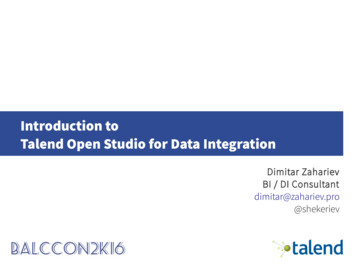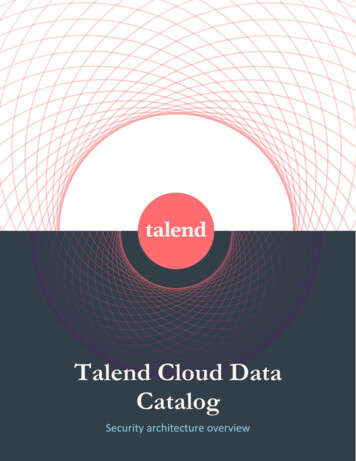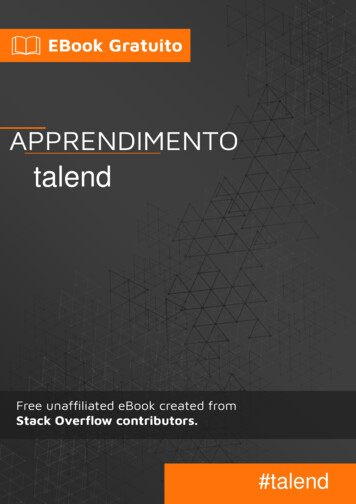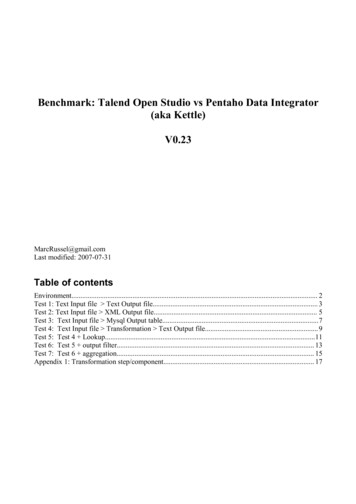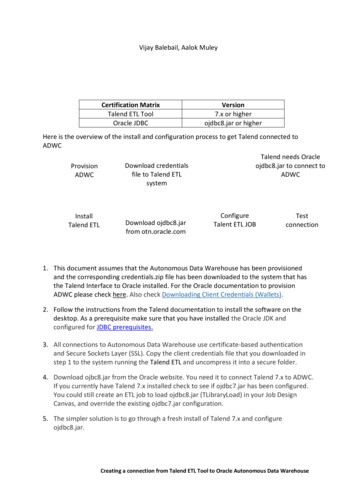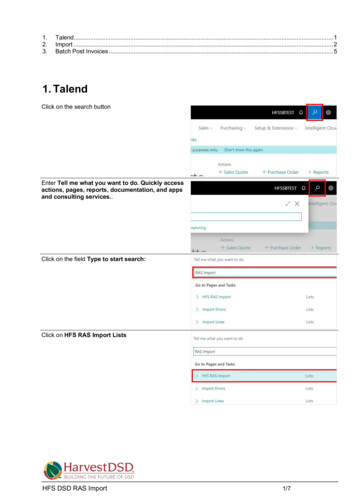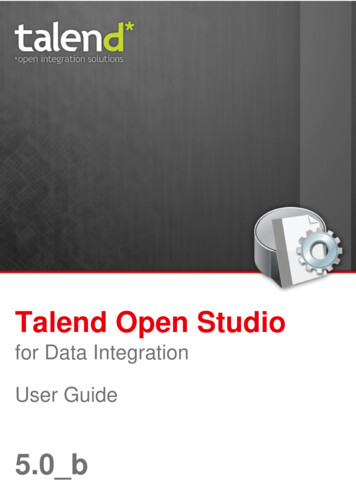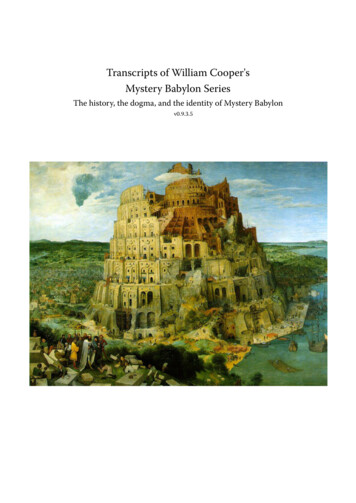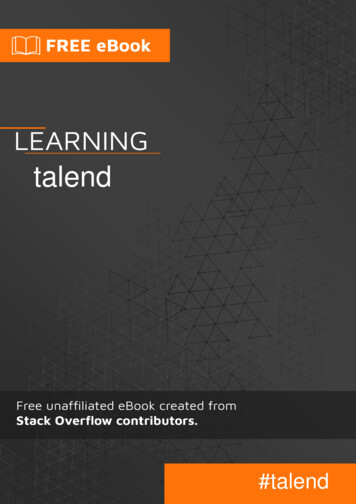
Transcription
talend#talend
Table of ContentsAbout1Chapter 1: Getting started with talend2Remarks2Examples2Installation or SetupChapter 2: Connectiong ComponentsExamplesIf / OnComponent / OnSubjobChapter 3: Types conversion in Talend23334Introduction4Examples4Table of ConversionsChapter 4: Using Date in TalendExamples455Parsing a date5Automatic date parsing5Credits7
AboutYou can share this PDF with anyone you feel could benefit from it, downloaded the latest versionfrom: talendIt is an unofficial and free talend ebook created for educational purposes. All the content isextracted from Stack Overflow Documentation, which is written by many hardworking individuals atStack Overflow. It is neither affiliated with Stack Overflow nor official talend.The content is released under Creative Commons BY-SA, and the list of contributors to eachchapter are provided in the credits section at the end of this book. Images may be copyright oftheir respective owners unless otherwise specified. All trademarks and registered trademarks arethe property of their respective company owners.Use the content presented in this book at your own risk; it is not guaranteed to be correct noraccurate, please send your feedback and corrections to info@zzzprojects.comhttps://riptutorial.com/1
Chapter 1: Getting started with talendRemarksThis section provides an overview of what talend is, and why a developer might want to use it.It should also mention any large subjects within talend, and link out to the related topics. Since theDocumentation for talend is new, you may need to create initial versions of those related topics.ExamplesInstallation or SetupDetailed instructions on getting talend set up or installed.Read Getting started with talend online: startedwith-talendhttps://riptutorial.com/2
Chapter 2: Connectiong ComponentsExamplesIf / OnComponent / OnSubjobThere are 2/3 options to connect components together in Talend. You should always try to useOnSubjob connectors. This saves a lot of headaches. You'll see from the examples why.What happens when you mix the connection types / What is the execution order?1. If2. OnComponent3. OnSubjobKeep in mind that the If connections gets evaluated runtime, which means if you use globalMapthen be really careful about the order.For example:- calls a subjob that resets this failure flag.(Boolean)globalMap.get("failure") false - calls a subjob that lets the main job continue,because the failure path resetted the flag.(Boolean)globalMap.get("failure") trueWhat is the a difference?If and Oncomponent connections act as a function call. Which makes the Garbage collector tokeep all the local data stored in memory. This could cause "memory leaks".OnSubjob connections on the other hand let the subjob complete and return, thus the GC will freeup some of the memory.Other than the memory there's also a few things you need to keep in mind. If you have a data flowthat reads from / writes to file, you should always go with OnSubjobOk as the data file will beclosed once the job completes. If you use onComponent it can happen that the file is not savedhence you start working with a 0 byte file, and after the job completes you'll see a file with content.It's logical but really hard to figure out.Read Connectiong Components online: ongcomponentshttps://riptutorial.com/3
Chapter 3: Types conversion in TalendIntroductionA list of type conversion in talend with some examples.ExamplesTable of Conversions From To Example String Integer Integer.parseInt(str) OR Integer.valueOf(str).intValue() String Date TalendDate.parseDate("dd-MM-yyyy", str) String BigDecimal new BigDecimal(str) String Float Float.parseFloat(str) OR Float.valueOf(str).floatValue(); String Long Long.parseLong(str) OR long l Long.valueOf(str).longValue() String Double double d Double.valueOf(str).doubleValue() Date String TalendDate.formatDate("yy-MM-dd", row1.myDate) Float String row1.myFloat.toString() Float BigDecimal new BigDecimal(Float.toString(row1.myFloat)) Float Double (float)d Float Integer First round : Math.round(), Math.ceil(), Math.floor() then cast the result to Integer Long Int (int)( row1.var 0) The max possible value is 2147483647 Long String row1.myLong.toString Integer Long row1.myInteger.longValue() Integer BigDecimal new BigDecimal(row1.myInteger) Integer Float new Float(row1.myInteger) Integer String variable "" OR variable.toString() BigDecimal Integer As with Float, BigDecimal can have decimal places, so will need to be rounded prior to casting to Integer BigDecimal String row1.myBigDecimal.toString() Double String String str Double.toString(d) Double Float double d f Read Types conversion in Talend online: version-in-talendhttps://riptutorial.com/4
Chapter 4: Using Date in TalendExamplesParsing a dateParsing date is used when having an input typed as String and when it is needed to get it as aDate. The class TalendDate contains method rn here is the input pattern, and not the expected output pattern.Usage : For an input string like "2017-05-0317:09:00", the call will be :TalendDate.parseDate("yyyy-MM-dd HH:mm:ss","2017-05-03 17:09:00")The result could be a date like :2017-05-03 17:09:00or03/05/2017Depending on the output pattern which is defined outside the parseDate method.Automatic date parsingSince Talend 6.3 , an option in tMap allows to automatically convert types. When activated, outputpattern is used as the expected input pattern to automatically convert data.First, activate the option :https://riptutorial.com/5
Then modify output pattern, used as the input pattern :Read Using Date in Talend online: te-in-talendhttps://riptutorial.com/6
CreditsS.NoChaptersContributors1Getting started withtalendCommunity2ConnectiongComponentsBalazs Gunics3Types conversion inTalendThéo Capdet4Using Date in TalendCorentinhttps://riptutorial.com/7
Chapter 1: Getting started with talend Remarks This section provides an overview of what talend is, and why a developer might want to use it. It should also mention any large subjects within talend, and link out to the related topics. Since the Documentation for talend is new, you may ne


